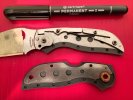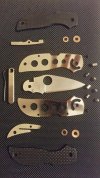Any advice on which area to file?
Bottom line added in here above all my BS further down that was my original replay :
OK I just finished doing my PD#1 Delica .
For most folks this won't be worth doing and I will get into why momentarily . Unless your lock up is unusually bad like my Man Bugs were then I would not bother filing your knife and even then maybe just send it in / send it back and get one that has very little slop and figure that is as good as it gets .
A tip : if you take your knife apart ; it is easier to disassemble if you take out the lock bar pivot post and the screw and remove the lock bar then disassemble the knife.
(remove the screw, push in on the lock bar at the pivot and push the pivot out with a blunt object that you can push in there )
It is easier to reassemble the knife if you leave the lock bar out and put the knife back together then push the lock bar into place against the spring with the blade open then insert the lock bar pivot post and then put the screw for that in. It is a good idea to have the end of the spring pushed all the way into the rectangular tunnel that captures the tail end of the spring .
I went a little nuts with this one and filed PAST THE NOTCH . Didn't make any real difference good or bad.
There is only so much that can be gained with filing this area .
I say for most folks this isn't worth doing because if you are like me you like a free pivot action , maybe even a drop shut action.
I found with this free / drop adjustment , part of the slop in the lock was from slop in the pivot . When I adjusted the pivot to have mostly zero play and so that I had to close the knife against my leg or use two hands then the slop in the lock was almost zero .
but
as soon as I relaxed the pivot for an easy wrist flick , like you see Eric do in new product videos , to partly swing the blade closed then there was a little noticeable lock rock when pressing down hard on a cutting board and once I adjusted it for drop shut ( just a degree or two counter clockwise on the pivot screw ) then I had more lock rock. Maybe less than I would have had before I filed it but no big woop .
Best blade pivot adjustment for minimal lock rock is to tighten the pivot firmly , close the blade almost all the way with the tip still out of the handle , loosen the pivot until the spring force over comes the pivot friction and the blade pops into the handle.
Another area of lock rock is if the lock bar pivot screw is not tightened down . Experiment with this also ..
OLD REPLY TO STILL SHOT BEFORE i OVERHAULED MY PD#1 DELICA :
I didn't say because I was afraid someone with more chutzpah than good judgement might file the wrong area .
On the lock bar , on the end that locks into the blade notch there is a tooth hanging down. Imagine this is a molar. The area where food would get masticated is where to file the tooth . On that surface there is a subtle kind of stepped area , at least there was on the last two I worked on. It is as if they did this intentionally to say to their workers file this area but don't go past the step or something bad might happen .
THAT IS A GUESS at why there is a step there .
I filed the step trying and fitting until the slop was just eliminated and no more .
Good luck.
Ope , senior moment see below after you read this .
PS : this is also the surface that runs on the rounded end of the blade tang while opening and closing the knife .
PPS : I just tested the last two I filed and there is still the slightest trace of play but at least not clunking while pressing down cutting against a cutting board.
I think from there it might take peaning / drawing out the metal there so if fills the notch in the blade more closely . Might make the area peened a bit brittle . Then you got to aneal it a bit . . . .
fun right ? ! ? !
My first thought is just hire people who can design stuff and manufacture stuff and quality control stuff .
In this day and age easier said than done .
I know they fired the main production / CADCAM guy years ago who ran off a thousand Sirens and they all had this problem . (I heard that straight from Sal in the forum)
My THREE Sirens are ALL PERFECT so maybe Sal or Eric stops in to manufacture those . . . don''t know .


